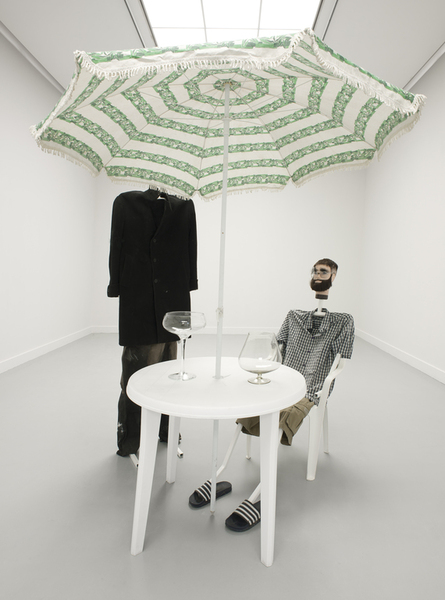I didn’t plan to write about this exhibition – I intended to write about another show at the Museum van Hedendaagse Kunst Antwerpen (M HKA), Moments on Moments, which features video works by prominent female performance artists. But as soon as I entered the exhibition space on the top floor of M HKA, I knew something was wrong. Chaotically curated, the works were displayed too close to one another, the screens were too small, sounds overlapped, and one of the televisions hadn't even been switched on. Apart from one early video work by Marina Abramovic, there was nothing particularly worth mentioning, nothing that will linger as positive in my mind.
Disillusioned, I took the elevator down to the second floor, where I walked into Jos de Gruyter and Harald Thys’Optimundus. After what I had just seen upstairs, it proved a relatively welcome surprise. The show features predominantly recent works by the two Flemish artists and is the largest exhibition of their work to date. The title Optimundus refers to the concept of a parallel world that exists in our imagination, a world which, according to these artists’ interpretations is multi-faceted, and often interferes with what we perceive to be real.
Jos de Gruyter and Harald Thys, So ist das, 2013 mixed media sculpture; Courtesy the artists, Galerie Isabella Bortolozzi, Galerie Micheline Szwajcer.
Video works bookend the exhibition. De Gruyter and Thys are best known for their projects in this medium and the space at M HKA is brilliantly equipped to show it. The video rooms are secluded from the rest of the exhibition and the building’s half round shape creates an interesting interior viewing space. My only critique was the quality of sound. In the room where a film about the artist's research project is shown, it was nearly impossible to distinguish the words of the narrator.
De Gruyter and Thys started their video projects some years ago when they interviewed people living in the margins of society. Intrigued by the stoic attitude of some of their subjects, they decided to create life-sized sculptures based on the people and film these fictional characters instead. In one of the videos, Les énigmes de Saarlouis (The Riddles of Saarlouis) (2012), two expressionless polystyrene faces belonging to the artists’ mannequin-like creations, are filmed in close-up. A mechanical sounding voiceover describes mundane demographic facts like “the man who smokes Marlboros has a neighbor who drinks water” or talks about a tramp scavenging for cigarette buds. The entire experience is space-age and sterile. It feels like we’re looking at the world from an alien point of view.
Jos de Gruyter and Harald Thys, Twee Vagebonden, 2013, mixed media sculpture; Courtesy the artists, Galerie Isabella Bortolozzi, Galerie Micheline Szwajcer.
Though De Gruyter and Thys explore the margins and edges of society, they express themselves in a subtle and, considering their subject, conservative way. There is little room for chaos – their work is considered, stylized, neat. The exhibition space is strategically filled with the artists’ fabricated brainchildren – an unhappy village populated with lifeless, marginal (or marginalized) men. So Ist Das (2013), for example, features a stereotypically dull looking man sitting at a plastic camping table. Twee Vagebonden (Two Vagabonds) (2013) depicts two murderers, coordinated in their tattered clothing, holding deadly knives mirroring their rigid, upright postures.
Optimundusis neither a breathtaking nor groundbreaking exhibition. I missed something crazy, perhaps an element of shock, or at least something that breaks with the stereotypes and cliches. The world created by Thys and de Gruyter is rather a subdued and tepid version of the real. At times it can be grim, or perhaps a little eerie, but the trivial, inescapable boredom displayed ceases to be confrontational and doesn't leave a lasting trace.
Optimundus will be continued in the beginning of 2014 in the Kunsthalle Wien, in Vienna.
[Image on top: Jos de Gruyter and Harald Thys, still from Les énigmes de Saarlouis (The Riddles of Saarlouis), 2012, video, 00:18:00; Courtesy the artists, Galerie Micheline Szwajcer, Private Collection.]

